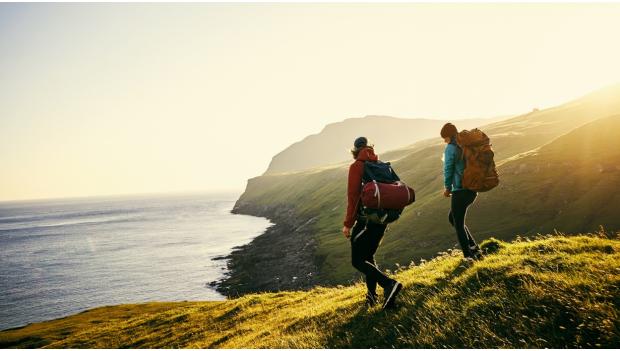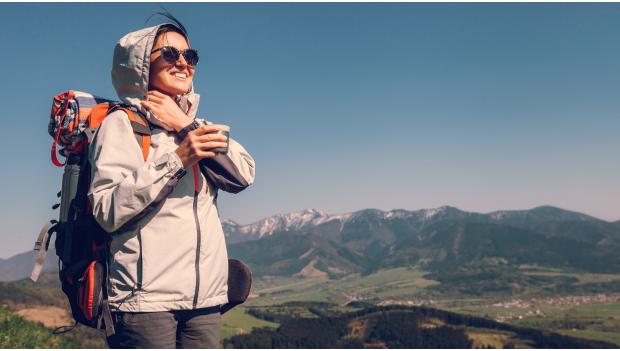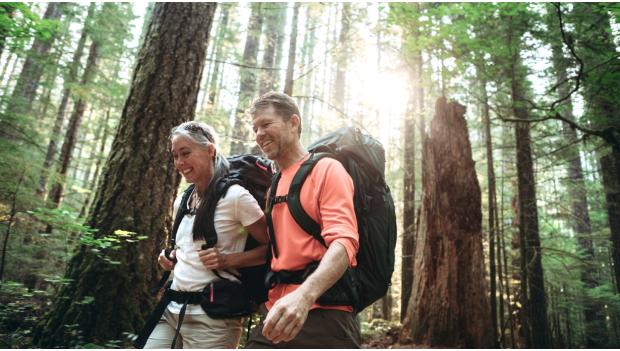
Hikers ready to take their outdoor adventure to the next level have come to the right place. This is your year to become a better backpacker, prepared for multi-day hiking trips paired with overnight camping in the backcountry. Different from a day hike, backpackers must carry everything they need for the duration of the getaway in their pack. This means supplies for hiking, eating, drinking and sleeping in nature. With this great challenge comes great rewards. To help you understand what it takes to succeed in backpacking, we have recommendations for before, during and after your trip.
Here are 9 tips to help you become a better backpacker.
1. Stretch on a regular basis
Hiking, particularly with a heavy backpack, can put serious strain on your muscles over a long period of time. Help prevent overuse injuries, mobility issues or muscular problems by stretching after a long day on the trail. Lower body stretches are key, but don’t neglect your back and shoulders. A foam roller is a great tool to have at home that will help flush out toxins and aid in the recovery process.
2. Honor backcountry camping rules
Leave No Trace principles are crucial in preserving our backcountry, and your process for picking a backcountry campsite should follow these rules. Backpackers should also honor the “200” rule: stash your bear canister downwind at a minimum of 200 feet, bury your body waste 200 feet from your camp or water source, and don’t set up camp within 200 feet of a body of water. These rules will help to keep unwanted critters from your campsite, and will prevent contamination in lakes or streams.

Recommended: How to Become a Better Fisherman
3. Fuel properly to increase energy
Depending on your mileage, you can burn thousands of calories every day while hiking on the trail. Especially important on long trips, account for these extra calories by consuming healthy, energy-dense and easily-packable meals and snacks. It’s always better to space out several small meals throughout the day, to maintain high energy levels. Keep the right macronutrient spectrum in mind (a healthy balance of carbs, fat and protein), and make sure you’re drinking enough clean water.
4. Outsmart pesky mosquitoes
Mosquitoes are one of the worst insects to encounter on the trail and at the campsite. They are relentless, but there are ways to keep them at bay. First, rinse sweat and odors off in a nearby lake or stream. Second, pick areas that are more exposed to wind (they can’t outfly seven mph gusts). Third, limit skin exposure by wearing lightweight fabric that can be buttoned or zipped up when needed.

Recommended: 10 Reasons Why Everyone Should Try Backpacking
5. Strengthen your core muscles
This isn’t for aesthetic purposes; a strong core is the foundation for all body movements out on the trail. When you’re carrying a 40-pound backpack, a strong core improves your balance, posture and mobility, reducing your risk of injury. Planks, crunches and leg lifts are three easy bodyweight exercises that will help strengthen your core when preparing for a backpacking trip.
6. Listen to your body and rest when needed
Backpacking is a marathon, not a sprint. It is crucial to pay attention to your body. If you’re feeling sluggish or drained, it’s usually a good idea to adjust your plans and call for a rest day. There’s no reason to push yourself to the edge, where you could lose mental clarity and potentially make careless decisions or risk getting injured in the backcountry. Rest, stretch, refuel and start fresh the next day.

Recommended: The Ultimate Guide to Outdoor Gear Rentals
7. Plan ahead, but stay flexible
Planning is essential for a successful backpacking trip. It takes time to put meals together, get the right gear, organize your backpack and map out your itinerary. Don’t skip these planning steps. But, also prioritize spontaneity and be open to change. For example, pack an extra day of supplies in case you find a hidden waterfall to explore. You shouldn’t have to say no to new adventures just because they weren’t pre-planned. Spontaneous detours can prove to be the best parts of backpacking trips.
8. Disconnect from technology
This is a great reminder for all of us, whether we’re backpacking or not. It’s likely that some remote trails still have cellphone reception, but that doesn’t mean you should connect. Challenge yourself to stay present in the moment and soak in your natural surroundings. That means keeping your devices tucked away, refusing to check emails and resisting the urge to post updates on Instagram until you’re back home. Keep your phone on hand for emergencies only.

Recommended: Itinerary: Backpacking the Trans-Catalina Trail
9. Invest in the right gear
Sure, your dad’s old external frame backpack from the ‘90s will get the job done, but don’t underestimate how bad gear can affect your experience. From the way a pack fits your body, to the multi-use design and built-in technologies, when you try on a new backpack you’ll instantly understand the difference. If you’re truly hooked on getting out in the backcountry (as we hope you are!), save up and invest in the right gear. This includes getting fitted for backpacking-specific hiking boots, a backpack that fits your hips and torso (plus the right volume for your trips), and a packable tent and sleeping bag. If you’re strapped for cash, check for gear deals at ACTIVE GearUp.